Overview
Leprosy, also known as Hansen's disease (HD), is a chronic disease caused by the bacteria Mycobacterium leprae and Mycobacterium lepromatosis. Named after physician Gerhard Armauer Hansen, leprosy is primarily a granulomatous disease of the peripheral nerves and mucosa of the upper respiratory tract. Skin lesions are the primary external sign . Left untreated, leprosy can be progressive, causing permanent damage to the skin, nerves, limbs, and eyes.

Leprosy
A 23-year-old man infected with leprosy.
Diagnosis
Diagnosis in the U.S. is often delayed because healthcare providers are unaware of leprosy and its symptoms. Early diagnosis and treatment prevents nerve involvement, the hallmark of leprosy, and the disability it causes. There are many kinds of leprosy, but there are common symptoms, including:
- Runny nose
- Dry scalp
- Eye problems
- Skin lesions
- Muscle weakness
- Reddish skin
- Smooth, shiny, diffuse thickening of skin on the face, ears, and hands
- Loss of sensation in fingers and toes
- Thickening of peripheral nerves
- Flat nose due to destruction of nasal cartilage
There is also phonation and resonation of sound during speech. Often there is atrophy of the testes and impotency.
Causative Agents
Mycobacterium leprae and Mycobacterium lepromatosis are the causative agents of leprosy. M. lepromatosis is a comparatively recently identified mycobacterium that was isolated from a fatal case of diffuse lepromatous leprosy in 2008. An intracellular, acid-fast bacterium, M. leprae is aerobic and rod-shaped, and is surrounded by the waxy cell membrane coating characteristic of Mycobacterium species. Due to extensive loss of genes necessary for independent growth, M. leprae and M. lepromatosis are obligate pathogens, and are unculturable in the laboratory, a factor that leads to difficulty in definitively identifying the organism under a strict interpretation of Koch's postulates. The use of non-culture-based techniques such as molecular genetics has allowed for alternative establishment of causation.
Routes of Infection
M. leprae is usually spread from person to person in respiratory droplets. Studies have shown that leprosy can be transmitted to humans through contact with armadillos, too. Leprosy is not known to be either sexually transmitted or highly infectious after treatment. Approximately 95% of people are naturally immune, and sufferers are no longer infectious after as little as two weeks of treatment. In 1988, Jacinto Convit was nominated for the Nobel Prize in Medicine for developing a vaccine to fight leprosy using a combination of tuberculosis (TB) vaccines with Mycobacterium Leprae. A number of synthetic pharmaceuticals that are effective against leprosy have now been identified, allowing doctors a flexible choice of treatments.